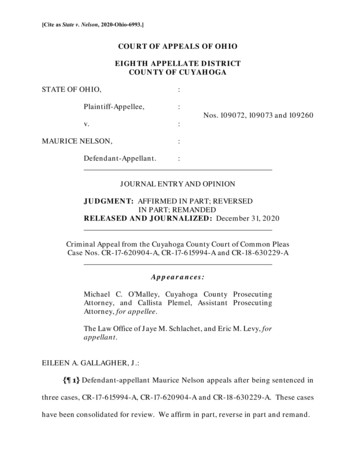Dr. C. Michael Nelson By Austin Wallace
Dr. C. Michael Nelsonby Austin WallaceEmeritus Professor, Department of Special EducationUniversity of Kentucky Lexington, KYResearcher in Residence, Department of Teaching andLearning, University of LouisvilleEducationBSE in Psychology and English, Kansas State Teachers College, 1965MS in School Psychology, Kansas State Teachers College, 1967Ed.D. in Special Education with emphasis on Emotionally Disturbed, University ofKansas, 1969Dr. Charles Michael Nelson is an internationally recognized special educator. Hiscontributions and dedication to serving children and youth with serious emotionaldisabilities in the special education and juvenile justice system have been recognizedwidely.Background InformationDr. Charles Michael Nelson was born on May 9, 1941 in Denver, Colorado. Hisfamily later moved to Kansas City, Kansas, where he grew up. At age 17, Dr. Nelsonjoined the Navy to expunge his then current, juvenile record. Overseas, he earned his
GED and completed training as a radar operator. He graduated with high honors. Uponhis discharge, he returned home to Kansas and entered college at Kansas State TeachersCollege (now Emporia State University). He majored in Psychology and English. Hecredits his majoring in English to his high school English teacher, Rosalie Stein. Alsobecause of her, he signed a contract to teach English at the middle school level inKansas City, KS. As a psychology major, he took several courses in special education.He also served as the President of the Psi Chi, which is the International Honor Societyin Psychology.Early LifeFollowing graduation, Dr. Nelson was hired by his mentor, Dr. Bill Tisdall, as anAssistant Professor in the Department of Special Education at the University ofKentucky. That first year was flawed by the unexpected death of Professor Tisdall. Dr.Nelson credits Dr. Tisdall with encouraging him to pursue a doctorate in specialeducation.At the University of Kentucky, Dr. Nelson proposed new approaches to teacherpreparation called “competency-based teacher education,” and developed acompetency-based leadership program in special education. In addition to competencybased teacher education, he was able to conduct research and training projects on
contingency management, applied behavior analysis, teacher consultation, positivebehavior support, and systems of care for children and families affected by emotionaland behavioral disorders. In addition to his role as coordinator of the graduate programfor teachers of students with emotional and behavioral disorders, he also served asDirector of Graduate Studies for the department from 1974-78, and as coordinator andprincipal investigator of the special education leadership preparation program from1985-93.Early in his career, Dr. Nelson noticed the lack of programs for children withemotional and behavioral problems in the state of Kentucky. He read about Project ReED (for re-education), an approach that was based on a European model for servingthese children of this nature. This project was started at Vanderbilt University byNicholas Hobbs. Dr. Nelson and a group of psychologists and educators visited Dr.Hobbs in Nashville, TN to learn more about the program. Upon their return theystarted their own Re-ED program in central Kentucky. Their proposal was granted, andfunds were allocated to them along with a site for the residential school. The localpublic schools agreed to supply the teacher-counselors, and Dr. Nelson agreed to trainthem. Central Kentucky Re-Ed operated successfully for 25 years.The outstanding work of Dr. Nelson kept him at UK for 35 years. During thistime Dr. Nelson met Mary Margaret Kerr, who encouraged Dr. Nelson to co-author a
text for educators dealing with children exhibiting challenging behavior. The book,Strategies for addressing behavior problems in the classroom, is now in its 6th edition andthird decade.In the late 1970s Dr. Nelson became involved in the Council for Children withBehavioral Disorders. He took an active role in the development and leadership of theorganization. He served as vice-president, president-elect, president, and pastpresident. Dr. Nelson also served as Chair of the Publications Committee for two terms(six years).Later WorkLater in his career Dr. Nelson became involved with a project designed to createan integrated system of care for children and families with emotional and behavioraldisorders. This project was called Bluegrass IMPACT (Interagency Mobilization forProgress in Adolescent and Children’s Treatment). It served 23 central Kentuckycounties and became a state-wide initiative. Later, it was changed to KentuckyIMPACT. Towards the end of his tenure at UK, he created partnerships in the NationalTechnical Assistance Center for Positive Behavioral Interventions and Supports (PBIS),the National Center on Education, Disability, and Juvenile Justice (EDJJ), and theKentucky Center for School Safety.
Involvement in the Juvenile Justice SystemSome of Dr. Nelson’s most important work outside of the special educationsystem was working with adolescents in the juvenile justice system (JJ). His immensework in this area can stand alone and is equally praiseworthy to anything else he hasdone. Dr. Nelson’s desire to work on the behalf of youth involved in the JJ systempossibly stems from his early experiences as an at-risk youth. He realized that manyyouth with EBD were in the JJ system. He saw that the vast majority of youth withdisabilities, including EBD, were not being appropriately served in juvenile correctionalor detention facilities. Dr. Rob Rutherford at Arizona State University had the samepassion, and together along with Error! Reference source not found., an AssistantProfessor in the College of Justice and Safety at Eastern Kentucky University; the threebegan looking at the needs of, and services for incarcerated juveniles. Together theywrote a grant entitled The Correctional/Special Education Training Project, or C/SET.The goal was to establish communication and collaboration between correctionaleducators and special educators to develop and test curricula for preparing correctionalspecial educators, and advocate for youth with disabilities in the JJ system. Theproposal was funded, and the C/SET project was launched.
In 1999, Rutherford, Wolford and Nelson along with Dr. Peter Leonecollaborated in writing another grant proposal. This one was called the National Centeron Education, Disability, and Juvenile Justice (EDJJ). They proposed for preventingyouth from entering the system through efforts in schools and communities; improvingprogramming within JJ facilities for better outcomes; and establishing effectivetransition services to facilitate successful re-entry into the community. The proposalwas approved and the project was jointly funded by the Department of Education andthe Department of Justice. One of Dr. Nelson’s main responsibilities in EDJJ wasconduct prevention research. Throughout a series of studies examining differencesbetween high-and low-performing schools in Kentucky, Dr. Nelson concluded thatefforts needed to be placed on implementing positive behavior support. This would bebeneficial both in preventing youth from entering the JJ system and improving theoutcomes of those in it. Thus Dr. Nelson has dedicated the rest of his life helpingimprove the plight of disadvantaged youthInfluences on Dr. Nelson’s WorkIt would be difficult to pinpoint or list the people who influenced C. MichaelNelson. With great humility, he believes that all of his colleagues, mentors and studentsdeserve equal if not more credit than himself for any accolades he has achieved.
According to him, the work has been shared and the benefits have been reciprocal.However, one of the books that inspired him as an early special educator was A NewLearning Environment by Harold L. Cohen and James Filipczak. Cohen and Filipczakdesigned a contingency-managed environment that provided incentives for academicand behavioral improvement for youth in an incarcerated facility, with very positiveresults. Dr. Nelson believes this formed the basis of positive behavior support. Afterretiring from UK, Dr. Nelson has continued his involvement with the national PBIScenter and facilitated the implementation of positive behavior support in programsinvolving at-risk and adjudicated youth, as well as those in alternative education andresidential treatment settings. He is currently working with the Texas YouthCommission to implement positive behavior support in all of the state’s secure juvenilejustice facilities.PublicationsIllback, R. J., & Nelson, C. M. (Eds.) (1996). Emerging school-based practices for childrenwith emotional and behavioral problems: Research and practice in service integration.NY: Haworth Press.Kerr, M. M., & Nelson, C.M. (2002). Strategies for addressing behavior problems (4th ed.).Upper Saddle River, NJ: Prentice Hall.
Kerr, M. M., Nelson, C. M., & Lambert, D. L. (1987). Helping adolescents with learning andbehavior disorders. Columbus, OH: Charles E. MerrillLeone, P. E., Rutherford, R. B., & Nelson, C. M. (1991) Special education in juvenilecorrections (CEC mini-library: Working with behavioral disorders). Reston, VA:Council for Exceptional Children.Nelson, C. M. (Ed.). (1978). Field-based teacher training: Applications in special education.Minneapolis, MN: Advanced Training Institute/Department ofPsychoeducational Studies, University of Minnesota, 1978.Nelson, C. M., & Pearson, C. A. (1991). Integrating services for children and youth withemotional and behavioral disorders. Reston, VA: Council for Exceptional Children.Nelson, C. M., Rutherford, R. B. Jr., & Wolford, B. I. (Eds.), (1987). Special education in thecriminal justice system. Columbus, OH: Charles E. Merrill.Nelson, C. M., Rutherford, R. B., & Wolford, B. (Eds.). (1996) Developing comprehensivesystems that work for troubled youth. Richmond, KY: National Juvenile DetentionAssociation.Nelson, C. M., Scott, T. M., & Polsgrove, L. (1999). Perspective on emotional/behavioraldisorders: Assumptions and their implications for education and treatment.Reston, VA: Council for Exceptional Children.Rutherford, R. B., & Nelson, C. M. (Eds.), (1984). Severe behavior disorders of childrenand youth (Vol. 7). Reston, VA: Council for Children with Behavioral Disorders.
Rutherford, R. B. Jr., Nelson, C. M., & Forness, S. R. (Eds.), (1987). Severe behaviordisorders of children and youth. San Diego, CA: College-Hill.Rutherford, R. B. Jr., Nelson, C. M., & Forness, S. R. (Eds.), (1988). Bases of severebehavioral disorders of children and youth. San Diego: College-Hill.Rutherford, R. B. Jr., Quinn, M. M., Leone, P. E., Garfinkel, L., & Nelson, C. M. (2002).Education,disability, and juvenile justice: Recommended practices. Reston, VA:Council for ExceptionalChildren.Wolford, B. I., Rutherford, R. B. Jr., & Nelson, C. M. (Eds.), (1986, May). Implementingtraining for correctional educators. Richmond, KY: Correctional/Special EducationTraining Project.Worell, J., & Nelson, C. M. (1974). Managing instructional problems: A case study workbook.New York: McGraw-Hill.Worell, J., & Nelson, C. M. (1974). Tratamiento de las difficultades educativas: Estudio decasos. Madrid, Spain: Anaya/2.
public schools agreed to supply the teacher-counselors, and Dr. Nelson agreed to train them. Central Kentucky Re-Ed operated successfully for 25 years. The outstanding work of Dr. Nelson kept him at UK for 35 years. During this time Dr. Nelson met Mary Margaret
Nelson-Siegel-Svensson.Nelson-Siegel and Nelson-Siegel-Svensson models using Ordinary Least Squares after fixing the shape parameters to make the models linear models. A t-test conducted is conducted on the adjusted R2 of the two models and results showed that Nelson-Siegel-Svensson model fits better the yield curves of the Bank
Arif Nelson Ewoldt Research Group University of Illinois at Urbana-Champaign 9 [Curtis-Fisk et al. 2013] [Nelson et al. Submitted] Hot Ice Cream Fingering Instability - The Rheology Zoo. Nasal Cavity . 8x Speed 200μm diameter tip. Orbitz Drink Hubba Bubba Bubble Tape [Nelson et al. JOR. 2018] Oil-in-water Emulsion [Rauzan and Nelson et al .
Vaughan Nelson) and ETFs (excluding those representing a strategy’s benchmark) will be deducted from the market value of a client’s account prior to the calculation of Vaughan Nelson’s management fee. Vaughan Nelson has negotiated fee schedules for certain clients wh
Nelson violated the community control terms. The court also found that in 615994, Nelson previously pleaded guilty to a third-degree felony and that he faced a potential 36-month sentence for that violation. The state outlined Nelson’s substantial criminal
Nelson Stud Welding, Inc. PH 1-800-NEL-WELD E-mail: Nelson.Sales@NelsonStud.com 7900 West Ridge Road 1-800-635-9353 Elyria, Ohio 44035 10/11 Nelson long style chucks are typically used when more acc
the original use of the Nelson product. This warranty does not extend to cover losses suffered to plants, animals, landscaping, or increased water usage in the event of a timer defect or malfunction. If a defect arises in a Nelson product or part within the warranty period, contact your Nelson
Nelson according to the Oregon State Seed Testing Laboratory is 99.49%. The ploidy level is 100% tetraploid. Breeding History Of Nelson Nelson is a 3-way cross from ryegrass breeding lines TXR2000-T2, TXR2002-T17, and the cultivar Jumbo (Prine et al., 2002). Jumbo is a tetraploid cultivar released by the University of Florida.
Basis for the industry’s worldwide operations Foundation of self-supporting programs including API Monogram More than 7000 active volunteers representing over 50 countries API Standards Program API publishes close to 700 technical standards























